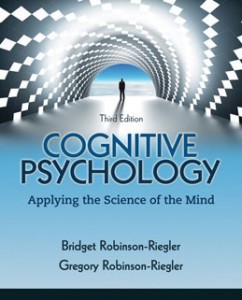Test Bank for Cognitive Psychology Applying The Science of the Mind, 3rd Edition: Robinson-Riegler
$35.00 Original price was: $35.00.$26.50Current price is: $26.50.
Test Bank for Cognitive Psychology Applying The Science of the Mind, 3rd Edition: Robinson-Riegler
Instant download Test Bank for Cognitive Psychology Applying The Science of the Mind, 3rd Edition: Robinson-Riegler pdf docx epub after payment.

Product details:
- ISBN-10 : 0205033644
- ISBN-13 : 978-0205033645
- Author: Bridget Robinson-Riegler
Cognitive Psychology: Applying the Science of the Mind combines clear yet rigorous descriptions of key empirical findings and theoretical principles with frequent real-world examples, strong learning pedagogy, and a straightforward organization.
For undergraduate courses in cognitive psychology.
Engagingly written, the text weaves five empirical threads — neuroscience, consciousness, individual differences, development, and culture — throughout the text to help students integrate the material. The text’s organization offers an intuitive description of cognition that enhances student understanding by organizing chapters around the flow of a piece of information that enters the cognitive system.
Table of contents:
Chapter 1—Cognitive Psychology: A Brief History and Introduction
What is Cognition?
The Omnipresence of Cognitive Processing
An Interdisciplinary Perspective
Psychology B.C. (Before Cognitive psychology)
Psychophysics
Structuralism: The Contents of Mental Experience
Functionalism: The Functions of Mental Experience
Behaviorism: The Rejection of Mental Experience
Laying the Foundation for Cognitive Psychology
The Emergence of Cognitive Psychology
S-R Explanations: Seriously wRong?
Technological Influences
PSYCHOLOGY A.D. (After Decline of behaviorism)
Behaviorism Reconsidered
Information-Processing: A Computer Metaphor for Cognition
Connectionism: A Brain Metaphor for Cognition
The Brain: More than a Metaphor
Current Trends in the Study of Cognition
Chapter 2—Perception and Consciousness: Basics of Information Intake
Basic Issues in Perception
Sensation and Perception
Bottom-Up and Top-Down Processing
The Basic Tasks of Visual Perception
Perceptual Organizational Processes
Multisensory Interaction and Integration
Synesthesia
Comparing the Senses
Perception and Action
Consciousness
Varieties of Consciousness
Disassociations of Consciousness
Subliminal Perception
Chapter 3—Mechanisms of Attention: Monitoring and Noticing Information
Attention: What is it?
Attention: Basic Characteristics
Pre-Attentive vs. Post-Attentive Processing
Visual Attention
Types of Visual Attention
Limits in Visual Attention
Auditory Attention
Selective Attention
Divided Attention
Automatic Processing
The Stroop Effect
Characteristics of Automatic Processing
Accounts of Automaticity
Costs of Automaticity
Driving: A Case Study in Attention
Driving and Auditory Attention
Driving and Visual Attention
Chapter 4 – Immediate Memory: The Control and Manipulation of Information
The Importance of Executive Attention
Immediate Memory: Basic Characteristics
Limits in Duration
Limits in Capacity
Coding
Theoretical Frameworks for Immediate Memory
The Modal Model
The Working Memory Model
A Unitary View of Memory
Embedded-Process View
Something We All Can Agree On: Capacity Limits and Forgetting
Who’s the Boss? Problems in Executive Control
Mind Wandering
Ironic Processes of Control
The Effects of Stress
Improving Executive Function
Chapter 5 – Objects and Concepts: Identifying and Classifying InformationIdentification and Classification: An Overview
Recognizing from the Bottom, Up and from the Top, Down
Object Recognition
Theories of Visual Object Recognition
Non-Visual Recognition
Face Recognition
Face Inversion
Holistic Processing
Is Face Recognition “Special”?
Individual Differences
Self-Recognition
Retrieving Names of Faces: Person Recognition
Networks and Concepts: The Classification Database
Semantic Networks
Concepts and Categories
Similarity-Based Categorization
Essentialist Approach: Concepts as Theories
Chapter 6 – Basic Processes in Long-Term Memory: Encoding and Retrieving Information
Fundamental Issues and Distinctions
Types of Long-Term Memory
A Descriptive Framework: Encoding, Storage, and Retrieval
LTM: Modes of Access and Use
Encoding Processes in Explicit Long-term Remembering
Attention and Repetition
Rehearsal
Levels of Processing
Self-Reference
Fitness-Relevant Processing
Organization and Distinctiveness
Remembering Action
Transfer Appropriate Processing
Retrieval Processes in Long–Term Memory
Availability and Accessibility
Encoding Specificity
Aging and Retrieval
Memory and Consciousness
Remembering and Knowing
Implicit Memory
Chapter 7 – Autobiographical Memory: Recalling Important Events from Life
Everyday Memory
Neisser’s Challenge: Ecological Validity and Memory Research
Autobiographical Memory: Basic Issues and Methodology
Memories vs. Facts
Methods of Investigation
Recalling a Life: Developmental Aspects of Autobiographical Memory
Childhood Amnesia
The Reminiscence Bump
Forgetting
Autobiographical Memory Retrieval
Encoding Specificity in Autobiographical Memory
Effective Cues for Autobiographical Memories
Models of Autobiographical Memory Retrieval
Involuntary Autobiographical Memories
Emotion and Autobiographical Remembering
Flashbulb Memories
Memory for Trauma
Mood and Autobiographical Remembering
Functions of Autobiographical Memory
Communicative Function
Emotional Function
Directive Function
Chapter 8 —-Malleability in Memory: Processes of Forgetting, Editing, and Distortion
The Sins of Memory
Eyewitness Memory
Encoding and Storage I: Event-Related Factors
Encoding and Storage II: Post-Event Factors
Retrieval Factors
Illusory Memories
Simple Events
Complex Events
False Remembering: Theoretical Frameworks
The Recovered Memory Controversy
Memories for Traumatic Events: Forgotten, Then Recalled?
Remembering and Forgetting Trauma: Ordinary Forgetting and Special Mechanisms?
False Memories for Traumatic Events?
Answering the Question
Chapter 9 – Language I: Basic Issues and Speech Processing
Language: Basic Principles
Linguistics and Psycholinguistics
Words and Rules
Design Features of Language
Language in Nonhuman Animals
Levels of Analysis
Phonology: The Sounds of Language
Phones and Phonomes
Morphology: From Sounds to Words
Producing (or “Morphing”) the Spoken Word
Perceiving the Spoken Word
Syntax and Semantics: From Words to Sentences
Transformational Grammar
Pragmatics: The Social Aspects of Language
Conversational Structure
Gender and Conversation
Putting it All Together: Language Production and Perception
Speech Production
Speech Perception
Motor Theory of Speech Perception
Auditory Theory of Speech Perception
A Re-Assessment: Kind of Special?
Chapter 10 –Language II: Reading and Comprehending Text
Mechanical Aspects of Reading
Top-Down and Bottom-Up Processes in Reading
Eye Movements
Word Recognition
Dyslexia
How Should Reading Be Taught?
Anglo-Centric Language Studies
Reading Myths
Sentence Level Processing
Sentence Parsing
Discourse Comprehension
Levels of Representation
Structure and Coherence
Discourse Memory and Representation
Memory for Discourse
Models of Discourse Comprehension
Metacomprehension
Speed Reading?
Chapter 11 – Judgments and Decisions: Using Information to Make Choices
Fundamental Concepts
The Focus on Errors
Dual-Process Views
Reasoning
Deductive Reasoning
Inductive Reasoning
Judgment
The Availability Heuristic
The Representative Heuristic
The Anchoring and Adjustment Heuristic
Biased Evaluation of Our Judgments
Decision Making
Expected Utility: A Normative Approach
Prospect Theory: A Descriptive Approach
Emotions and Decision Making
Decisions Making: Biases or Adaptive Tools?
Improving Decision Making
Chapter 12 – Problems and Goals: Using Information to Arrive at Solutions
What is a Problem?
Well-Defined and Ill-Defined Problems
Routine and Nonroutine Problems
Problem-Solving Research: Some Methodological Challenges
Approaches to the Study of Problem Solving
Behaviorism: Problem Solving as Associative Learning
Gestalt Psychology: Problem Solving as Insight
Cognitive Psychology: Problem Solving as Information Processing
Problem Representation
Rigidity in Problem Representation
Individual Differences in Problem Representation
Problem Solution
Algorithms
Heuristics
Experts: Masters of Representation and Solution
Expert Advantages
Expert Disadvantages: Costs of Expertise
Insight and Creativity
Insight
Creativity
References
Photo Credits
Name Index
Subject Index
People also search:
Cognitive Psychology Applying The Science of the Mind
Cognitive Psychology Applying The Science of the Mind Robinson-Riegler
Cognitive Psychology Applying The Science of the Mind Robinson-Riegler 3rd
Cognitive Psychology Applying The Science of the Mind Robinson-Riegler 3rd Test Bank
Test Bank for Cognitive Psychology Applying The Science of the Mind, 3rd Edition: Robinson-Riegler Download
You may also like…
Test Bank
Test Bank for Cognitive Neuroscience: The Biology of the Mind (Fifth Edition) Fifth Edition
Test Bank
Test Bank for Evolutionary Psychology: The New Science of the Mind, 4/E 4th Edition David Buss












